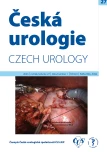The WHO Classification of Urinary and Male Genital Tumours 2022: news in the urinary tract neoplasms classification
Authors:
Tomáš Pitra 1; Adriena Bartoš Veselá 1; Josef Skopal 2; Milan Hora 1; Ondřej Hes 2,3; Ondřej Fiala 4; Kristýna Pivovarčíková 2,3
Authors‘ workplace:
Urologická klinika, Lékařská fakulta Plzeň, Univerzita Karlova a Fakultní nemocnice Plzeň
1; Šiklův ústav patologie, Lékařská fakulta Plzeň, Univerzita Karlova a Fakultní nemocnice Plzeň
2; Bioptická laboratoř, s. r. o., Plzeň
3; Onkologická a radioterapeutická klinika, Lékařská fakulta Plzeň, Univerzita Karlova a Fakultní, nemocnice Plzeň a Biomedicínské centrum, Lékařská fakulta Plzeň, Univerzita Karlova, †zesnulý
4
Published in:
Ces Urol 2023; 27(1): 9-16
Category:
Review articles
Overview
The classification of urinary tract neoplasms (so-called blue book) only slightly modifies the last WHO version from 2016. The major change is the modification of the arrangement of the chapters and only minor changes occurred in the nomenclature. The aim of this review is to outline and comment on the changes in the new edition of the WHO classification 2022 of the urinary tract.
Keywords:
classification – urothelial carcinoma – urinary tract – WHO
Sources
1. Tsuzuki T, Compérat E, Netto G, et al. Tumours of the urinary tract. In: WHO Classification of Tumours Editorial Board. Urinary and male genital tumours. Lyon (France): International Agency for Research on Cancer WHO classification of tumours series, 5th ed.; vol. 8; 2022.
2. Kamoun A, de Reyniès A, Allory Y, et al. A Consensus Molecular Classification of Muscle‑invasive Bladder Cancer. Eur Urol. 2020; 77(4): 420–33.
3. Rosenthal D, Wojcik E, Kurtycz D. The Paris system for reporting urinary cytology. Switzerland: Springer; 2016.
4. Wojcik EM, Kurtycz DFI, Rosenthal DL. We’ll always have Paris The Paris System for Reporting Urinary Cytology 2022. J Am Soc Cytopathol. 2022; 11(2): 62–6.
5. Pitra T, Dikanová M, Hora M, et al. Porovnání výsledků invazivních vyšetření a močové cytologie: Zkušenosti jednoho urologického centra po prvním roce užívání Pařížské klasifikace pro hodnocení močových cytologií. Ces Urol. 2018; 22(4): 275–84.
6. Amin MB, Comperat E, Epstein JI, et al. The Genitourinary Pathology Society Update on Classification and Grading of Flat and Papillary Urothelial Neoplasia With New Reporting Recommendations and Approach to Lesions With Mixed and Early Patterns of Neoplasia. Adv Anat Pathol. 2021; 28(4): 179–95.
7. Compérat E, Amin MB, Epstein JI, et al. The Genitourinary Pathology Society Update on Classification of Variant Histologies, T1 Substaging, Molecular Taxonomy, and Immunotherapy and PD‑L1 Testing Implications of Urothelial Cancers. Adv Anat Pathol. 2021; 28(4): 196–208.
8. Gutierrez CM, Alemozaffar M, Osunkoya AO. Invasive high‑grade urothelial carcinoma of the bladder, renal pelvis, ureter, and prostatic urethra arising in a background of urothelial carcinoma with an inverted growth pattern: a contemporary clinicopathological analysis of 91 cases. Hum Pathol. 2019; 92: 18–24.
9. Amin MB, Smith SC, Reuter VE, et al. Update for the practicing pathologist: The International Consultation On Urologic Disease‑European association of urology consultation on bladder cancer. Mod Pathol. 2015; 28(5): 612–30.
10. McKenney JK. Precursor lesions of the urinary bladder. Histopathology. 2019; 74(1): 68–76.
11. McKenney JK. Urothelial carcinoma in situ: diagnostic update. Pathology. 2021; 53(1): 86–95.
12. Parwani AV, Levi AW, Epstein JI, Ali SZ. Urinary bladder biopsy with denuded mucosa: denuding cystitis‑cytopathologic correlates. Diagn Cytopathol. 2004; 30(5): 297–300.
13. Sheldon CA, Clayman RV, Gonzalez R, Williams RD, Fraley EE. Malignant urachal lesions. J Urol. 1984; 131(1): 1–8.
14. Brierley JD, Gospodarowicz MK, Wittekind C. TNM Classification of malignant tumours, 8th edition. Wiley‑Blackwell; 2016: 272.
15. Idrees MT, Alexander RE, Kum JB, Cheng L. The spectrum of histopathologic findings in vesical diverticulum: implications for pathogenesis and staging. Hum Pathol. 2013; 44(7): 1223–32.
16. Lloyd R, Osamura R, Kloppel G, Rosai J. WHO Classification of Tumours of Endocrine Organs (4th Edition). Lyon (France): International Agency for Research on Cancer (IARC); 2017.
17. Acosta AM, Demicco EG, Dal Cin P. Pseudosarcomatous myofibroblastic proliferations of the urinary bladder are neoplasms characterized by recurrent FN1-ALK fusions. Mod Pathol. 2021; 34(2): 469–77.
18. Babjuk M, Burger M, Compérat EM, et al. European Association of Urology Guidelines on Non‑muscle‑invasive Bladder Cancer (TaT1 and Carcinoma In Situ) – 2019 Update. Eur Urol. 2019; 76(5): 639–57.
Labels
Paediatric urologist Nephrology UrologyArticle was published in
Czech Urology

2023 Issue 1
Most read in this issue
- The WHO Classification of Urinary and Male Genital Tumours 2022: news in the urinary tract neoplasms classification
- Rare complications post intravesical application of Bacillus-Calmette Guérin (BGG) vaccine
- Rare thrombosis of pampiniform plexus in a COVID-19 patient – a case report
- Obesity and risk of prostate cancer
